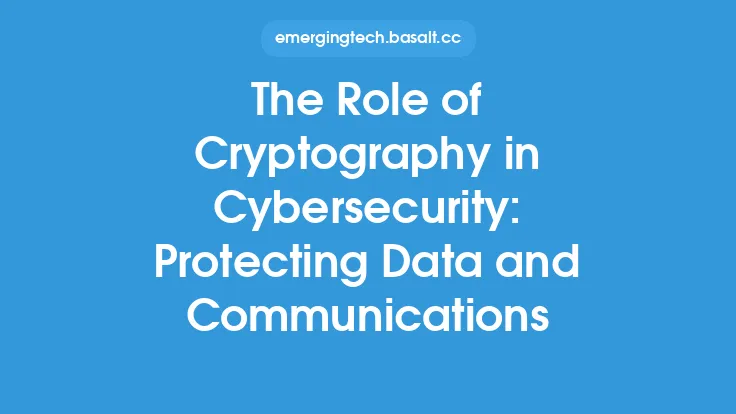In today's digital landscape, cybersecurity is a top priority for organizations of all sizes. As cyber threats continue to evolve and become more sophisticated, it's essential to have a robust cybersecurity posture in place to protect against potential attacks. One crucial component of a strong cybersecurity strategy is threat intelligence. Threat intelligence refers to the process of gathering, analyzing, and disseminating information about potential or actual cyber threats. This information can be used to inform and improve an organization's cybersecurity decisions, ultimately enhancing its overall cybersecurity posture.
What is Threat Intelligence?
Threat intelligence is a critical component of cybersecurity that involves the collection and analysis of data related to cyber threats. This data can come from a variety of sources, including open-source intelligence, social media, and internal network traffic. Threat intelligence can be used to identify potential threats, understand the tactics and techniques used by attackers, and develop strategies to mitigate or prevent attacks. There are several types of threat intelligence, including strategic, tactical, and operational intelligence. Strategic intelligence provides high-level information about the threat landscape, while tactical intelligence focuses on specific threats and how to counter them. Operational intelligence, on the other hand, provides real-time information about ongoing attacks and how to respond to them.
The Benefits of Threat Intelligence
The benefits of threat intelligence are numerous. By leveraging threat intelligence, organizations can gain a better understanding of the cyber threats they face and make informed decisions about how to protect themselves. Threat intelligence can help organizations identify vulnerabilities in their systems and prioritize remediation efforts. It can also be used to develop targeted security controls and incident response plans, ultimately reducing the risk of a successful attack. Additionally, threat intelligence can help organizations stay ahead of emerging threats by providing early warnings of potential attacks. This allows organizations to take proactive measures to prevent attacks, rather than simply reacting to them after they occur.
How Threat Intelligence Works
Threat intelligence works by collecting and analyzing data from a variety of sources. This data can include information about known threats, such as malware and phishing campaigns, as well as information about potential threats, such as suspicious network activity. The collected data is then analyzed using specialized tools and techniques, such as machine learning and natural language processing. The analyzed data is used to create threat intelligence feeds, which provide real-time information about potential and actual cyber threats. These feeds can be used to inform and improve an organization's cybersecurity decisions, such as blocking malicious IP addresses or developing targeted security controls.
Threat Intelligence Feeds
Threat intelligence feeds are a critical component of threat intelligence. These feeds provide real-time information about potential and actual cyber threats, allowing organizations to stay up-to-date on the latest threats and take proactive measures to protect themselves. There are several types of threat intelligence feeds, including IP reputation feeds, domain reputation feeds, and malware signature feeds. IP reputation feeds provide information about known malicious IP addresses, while domain reputation feeds provide information about known malicious domains. Malware signature feeds, on the other hand, provide information about known malware and how to detect and prevent it.
Implementing Threat Intelligence
Implementing threat intelligence requires a structured approach. The first step is to define the organization's threat intelligence requirements, including the types of threats to be monitored and the sources of threat intelligence data. The next step is to collect and analyze the data, using specialized tools and techniques such as machine learning and natural language processing. The analyzed data is then used to create threat intelligence feeds, which provide real-time information about potential and actual cyber threats. Finally, the threat intelligence feeds are integrated into the organization's cybersecurity systems, such as firewalls and intrusion detection systems, to inform and improve cybersecurity decisions.
Threat Intelligence Tools and Techniques
There are several threat intelligence tools and techniques available, including threat intelligence platforms, security information and event management (SIEM) systems, and incident response platforms. Threat intelligence platforms provide a centralized location for collecting, analyzing, and disseminating threat intelligence data. SIEM systems, on the other hand, provide real-time monitoring and analysis of network traffic, allowing organizations to detect and respond to potential threats. Incident response platforms provide a structured approach to responding to security incidents, including tools for incident detection, containment, and remediation.
Challenges and Limitations of Threat Intelligence
While threat intelligence is a critical component of cybersecurity, there are several challenges and limitations to its implementation. One of the main challenges is the sheer volume of threat intelligence data available, which can be overwhelming to analyze and disseminate. Another challenge is the lack of standardization in threat intelligence data, which can make it difficult to integrate and share data between different systems and organizations. Additionally, threat intelligence requires significant resources and expertise, including specialized tools and techniques, which can be a barrier to implementation for smaller organizations.
Best Practices for Threat Intelligence
There are several best practices for threat intelligence, including defining clear threat intelligence requirements, collecting and analyzing data from multiple sources, and integrating threat intelligence feeds into cybersecurity systems. Organizations should also prioritize threat intelligence based on risk, focusing on the most critical threats and vulnerabilities. Additionally, organizations should continuously monitor and evaluate their threat intelligence capabilities, making adjustments as needed to stay ahead of emerging threats. Finally, organizations should share threat intelligence data with other organizations and industry partners, helping to create a collective defense against cyber threats.
The Future of Threat Intelligence
The future of threat intelligence is rapidly evolving, with new technologies and techniques emerging all the time. One of the most significant trends is the use of artificial intelligence and machine learning to analyze and disseminate threat intelligence data. These technologies can help organizations to quickly and accurately identify potential threats, and to develop targeted security controls to prevent attacks. Another trend is the use of cloud-based threat intelligence platforms, which provide a centralized location for collecting, analyzing, and disseminating threat intelligence data. Finally, there is a growing recognition of the importance of sharing threat intelligence data between organizations and industry partners, helping to create a collective defense against cyber threats.





